Review of the PNY XLR8 CS3140 PCIe Gen 4 NVMe SSD
Many PS5 users who are making their first big steps into the world of current-generation SSD storage to upgrade their consoles are having to wrap their heads around quite a lot of terminology, interfaces and brands that most well establish PC gamers are already pretty well aware of. The sad truth is that despite the PS5 being a home console, designed for simplicity, in order to upgrade your storage via the systems m.2 SSD upgrade slot, you will need to get a little more clued up! One of the brands that have made tremendous waves in the world of prosumer/gaming SSD storage is PNY (which stands for Paris-New-York – something I did not know till recently I might add, every day is a school day!) with their XLR8 Gaming series. Currently, their best prosumer SSD for gamers is the CS3140 PCIe 4 NVMe SSD and it was one of the earliest picks for an SSD that would be PS5 compatible when it was launched in spring 2021. Several firmware updates later, PS5 compatibility confirmed and better pricing, the PNY XLR8 CS3140 has shot back into the shopping basket of many gamers who are looking for top performance from their storage, whilst still maintaining a good price point. So, today I want to review the CS3140 SSD, see if the fastest PNY XLR8 SSD still cuts the mustard and (in light of their recent PS5 designed heatsink – review HERE) whether it deserves a place in your gaming machine? Let’s begin.
PNY XLR8 CS3140 SSD Review – Quick Conclusion
The PNY XLR8 CS3140 SSD is a solid enough SSD that although holds back on the presentation a little bit, more than makes up for it in top tier performance, fair pricing and not overpromising what it can do. In many SSDs cases, the marketing of these drives might be overestimating what they can do, or keeping quiet about where it falls short, however in the case of the PNY XLR8 CS3140 we have an honestly presented and reliable SSD. Add to that the recent release of the brand’s own PS5 heatsink and you have every approachable bundle purchase here that a lot of straightforward console buyers will be drawn to. The architecture of the PNY XLR8 CS3140 (Phison E18, Micron 3D TLC 96L NAND, 0.38DWPD, etc) might well be a recipe we have seen oft-repeated by SSD brands in the last 12 months over and over again, but the CS3140’s strength is in providing this at a price point notably lower than most. That said, low availability and a sudden gear shift by the brand to move its PC gaming label ‘XLR8’ to extend towards PS5 notoriety is not quite as strong as it might like. Overall, there is little reason not to choose this for your PS5 purchase and in particular if the PS5 designed heatsink bundle appears in your region. A predictable, but still very worthy SSD in 2022.
PNY XLR8 CS3140 SSD Review – Packaging
The packaging for the PNY XLR8 CS3140 is a mixture of loud, gamer-brash spec shouting and a little thin on the ground contents. This is by no means unusual and indeed, most brands don’t have much to include in their retail kits (assuming most buyers will have the rest of the possibly useful accessories such a thermal pads, heatsinks, screws and screwdrivers already. That said, the PNY XLR8 CS3140 is pretty baren for contents even by modern standards of SSD kits.
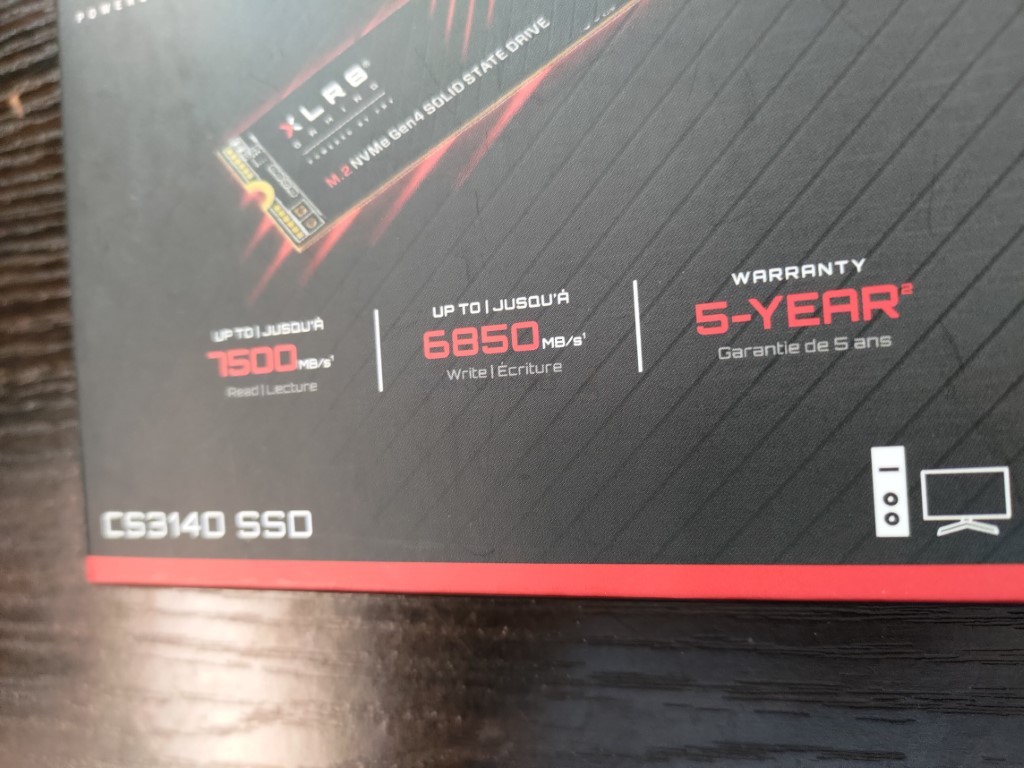
The box of the PNY XLR8 CS3140 talks about those high-end performance figures that this SSD can hit in the optimal PC, as well as a lot of the XLR8 branded livery that is going to be instantly recognizable to any gamer even slightly familiar with this series, but inside is the SSD only and it is held in a plastic moulded shallow cut frame.
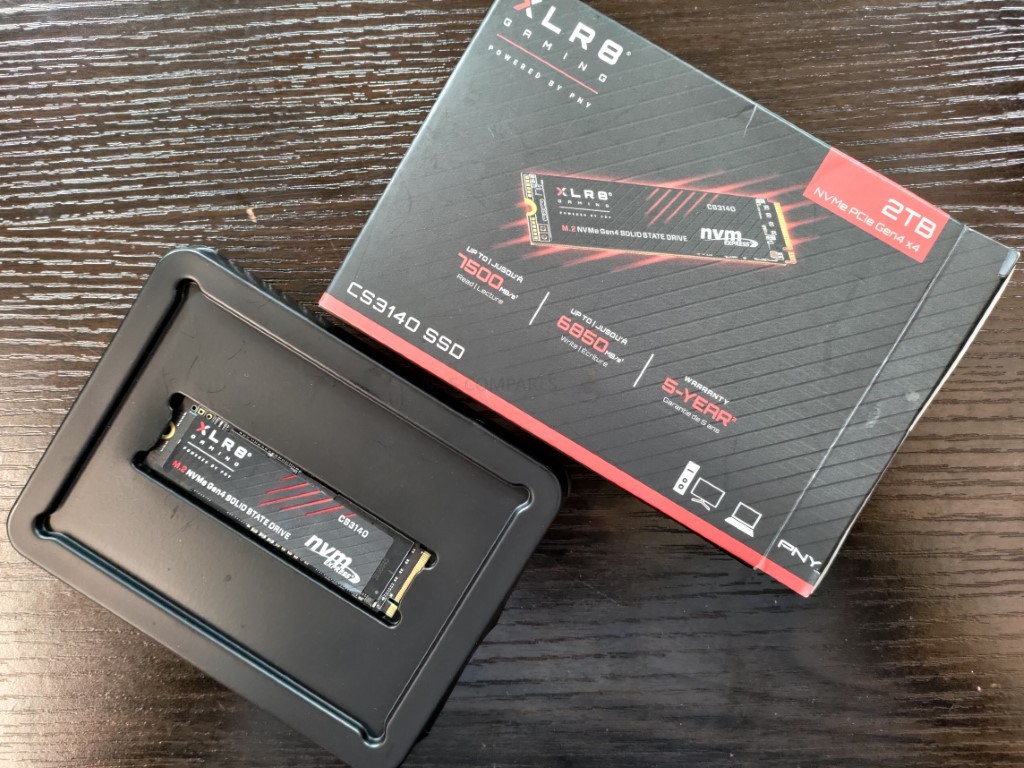
The SSD does not include paper information on the setup instructions, warranty, troubleshooting or installation, as that information is all covered on the rear of the box. So, some users might like this saving on waste and others might feel this is a bit compressed. I am happy with it, but jsut wish that the PNY XLR8 CS3140 retail kit included thermal pads (even in spite of this being a non-heatsink inclusive model) as if you are replacing an existing M.2 SSD in your PS5/PC, you would not really want to reuse the thermal pads you have already. Still, a very minor gripe indeed.
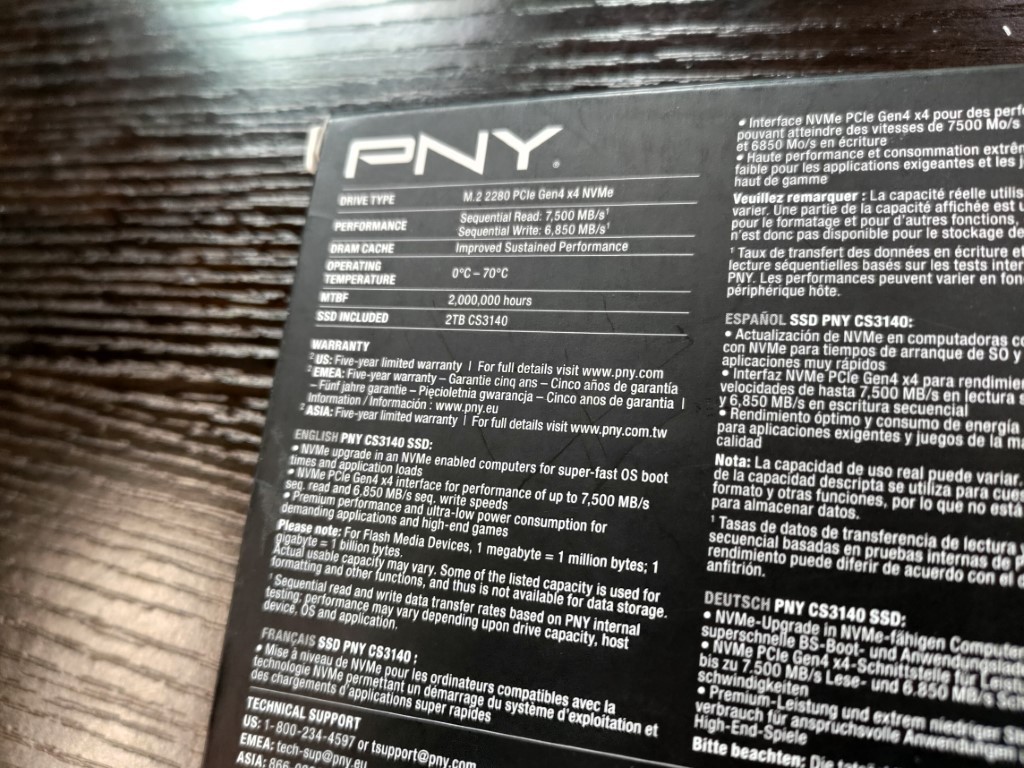
Removing the retail packaging shows us the PNY XLR8 CS3140 in all its glory. Much like 95% of all other m.2 SSDs, it arrives as a bare PCB, as these SSDs can get real hot and need as much airflow and heat dissipation directly connected to the SSD chips as possible. Therefore it makes it very difficult for any brand to personalize an SSD in any kind of designer way. The PNY XLR8 CS3140 has a branded label front and back that simply denote the model ID, capacity and serial number. That is about it. Again, not unusual, but makes any kind of stand out design much more based on chip architecture than any kind of aesthetic appeal.
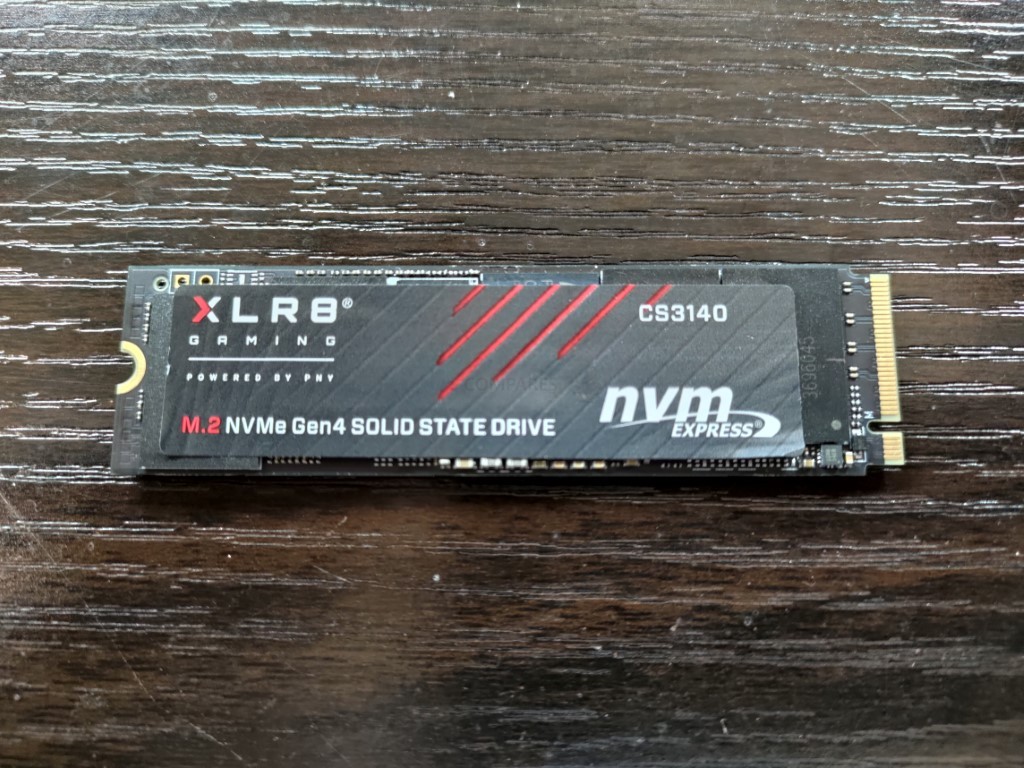
The PNY XLR8 CS3140 SSD when installed, will likely rarely be seen ever again (both in a PC or a PS5 environment), but the appeal of the CS3140 in light of recent the brand’s new PS5 designed heatsink that addresses the dissipation questions around the PS5 expansion slot means that many buyers looking to upgrade their Playstation storage will look the SSD+Heatsink bundle offered by the websites as both great values and considerably more convenient. Once again, this heatsink uses that oh, so familiar XLR8 design:
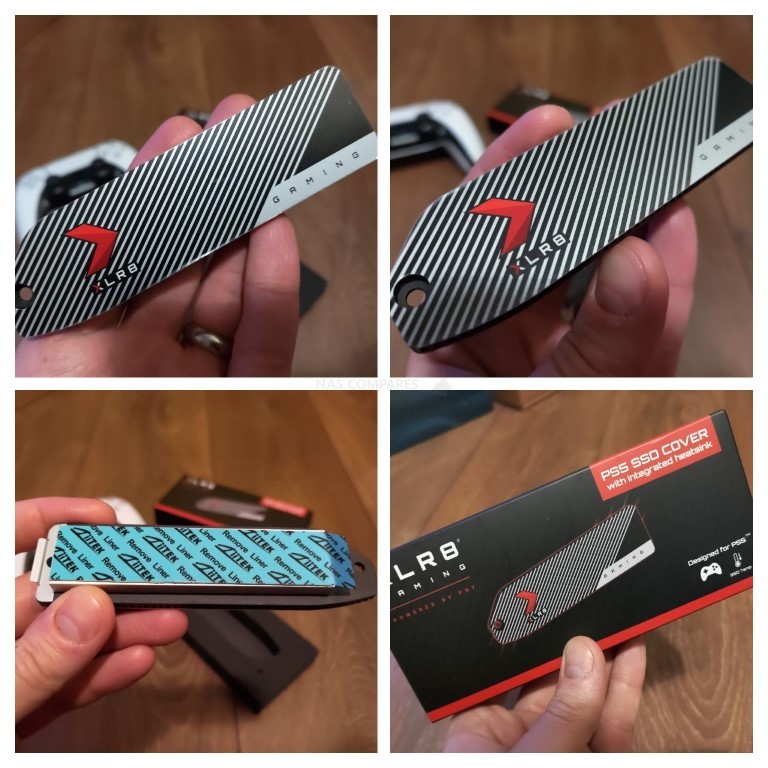
Indeed, installation of the PNY PS5 Designed Heatsink on top of the PNY XLR8 CS3140 SSD is incredibly easy and replaces the oddly designed m.2 SSD cover plate that the PS5 arrives with, as well as including a replacement cover screw on the console.
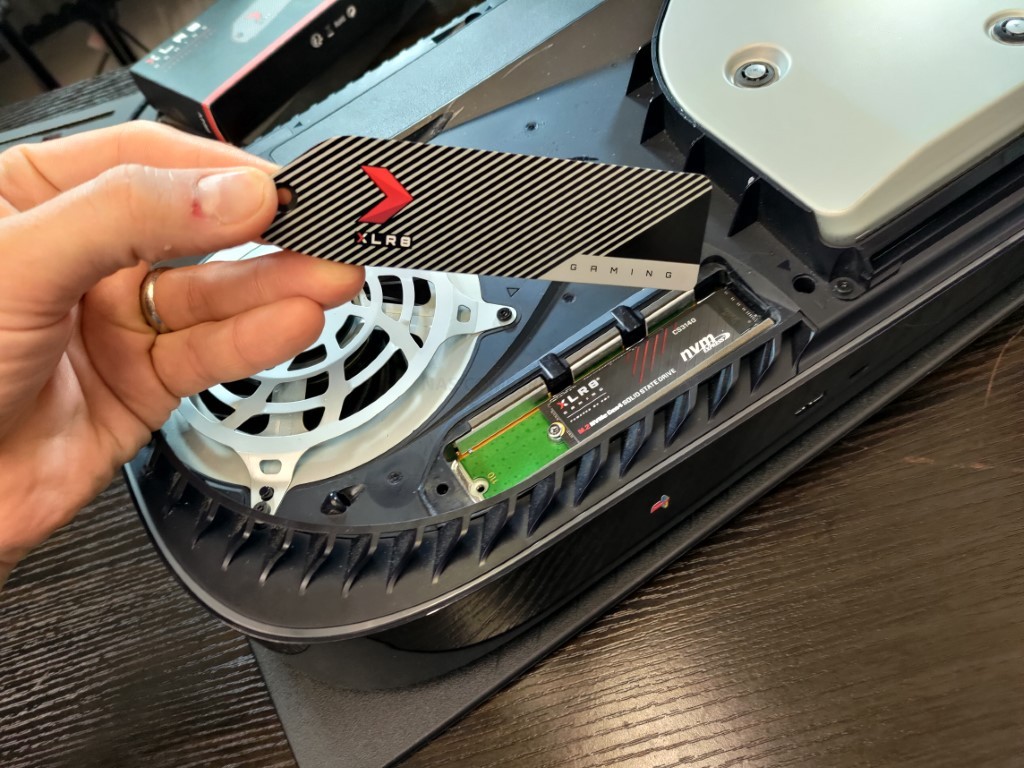
So, you can see why the PNY XLR8 CS3140 has suddenly started making waves again in the PS5 upgrade market, as this heatsink adds a lot of improved SSD temperature possibilities and therefore potentially improved games loading and performance. The Heatsink sits in the available expansion slot on top of the m.2 SSD and although is clearly prominent, it doe not interfere or protrude into the passive airflow of the PS5 internal fan assembly by any real negative degree.
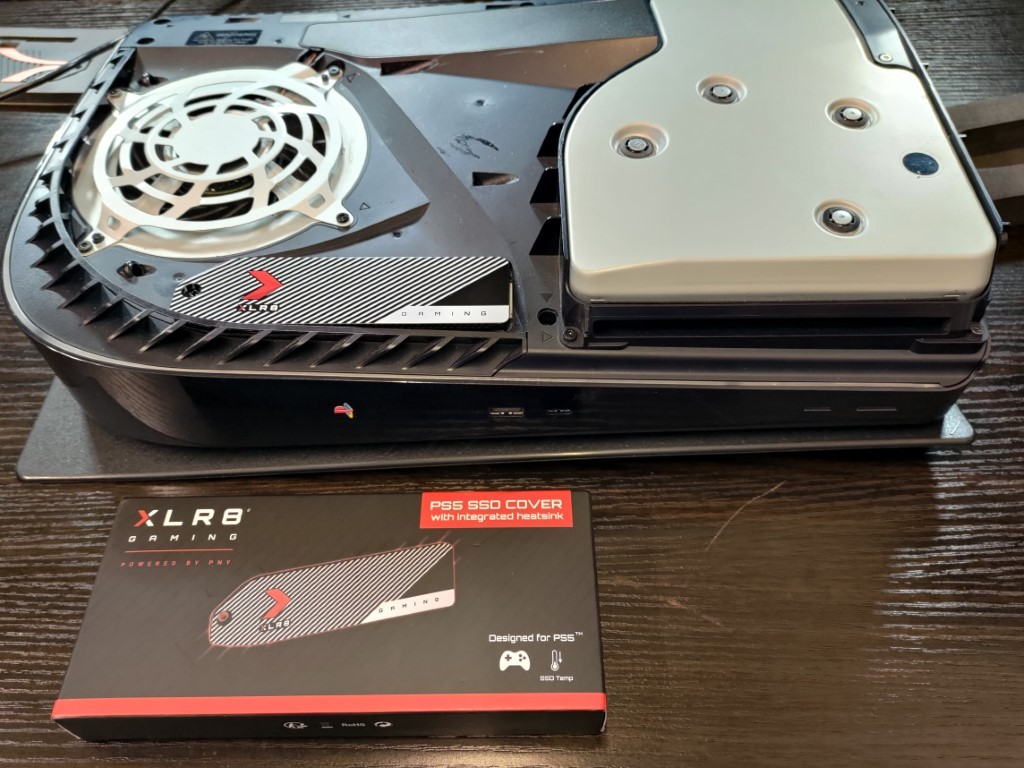
We even took the time to test just how the temperature of the PS5 ambient airflow AND the temperature of the PNY XLR8 CS3140 SSD compared with the same SSD with a budget $10 M.2 SSD heatsink. Below (in the video) was how they compared and unsurprisingly, the PNY PS5 designed heatsink was the winner by a country mile.
The SSD itself does not seem to run much hotter than the average Phison E18 SSD in the market right now and the PNY XLR8 CS3140 SSD when installed in our PC testing comfortably stayed under 50 degrees through all the tests of sustained read and write atacks.
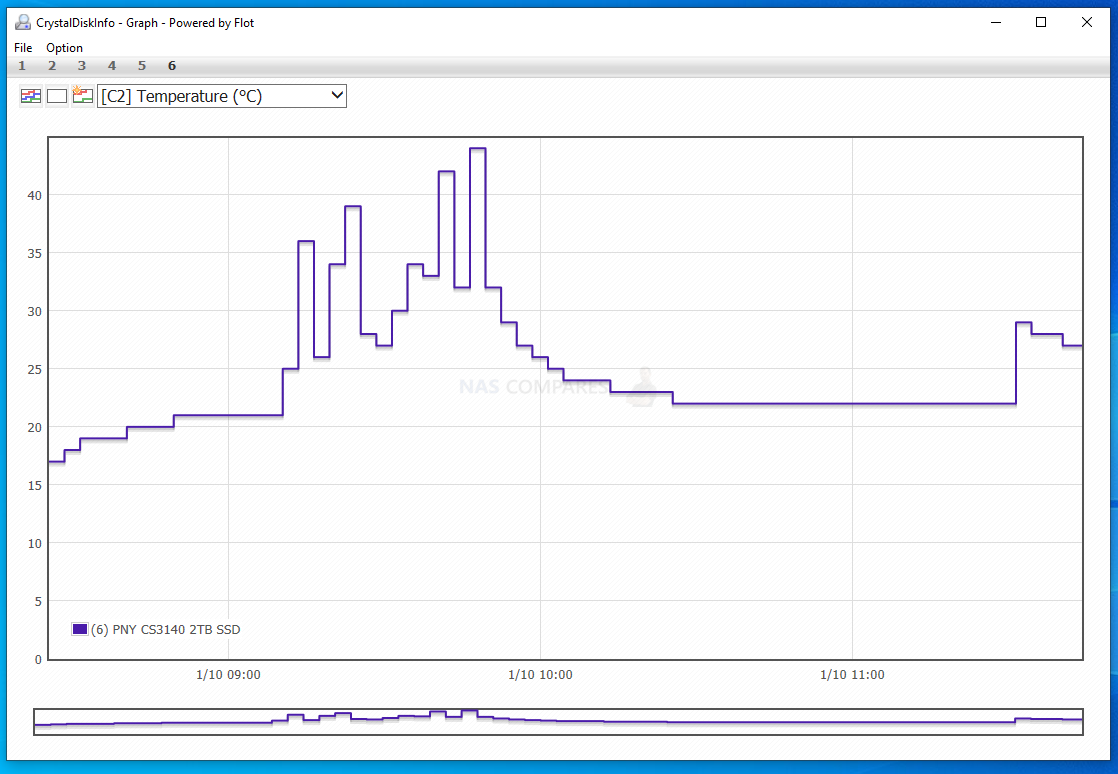
When installing the PNY XLR8 CS3140 in the PS5, we performed a benchmark using the system’s own tool several times and although the highest it achieved was 6,541MB/s, the best average temp was around 6,200-6,300MB/s.
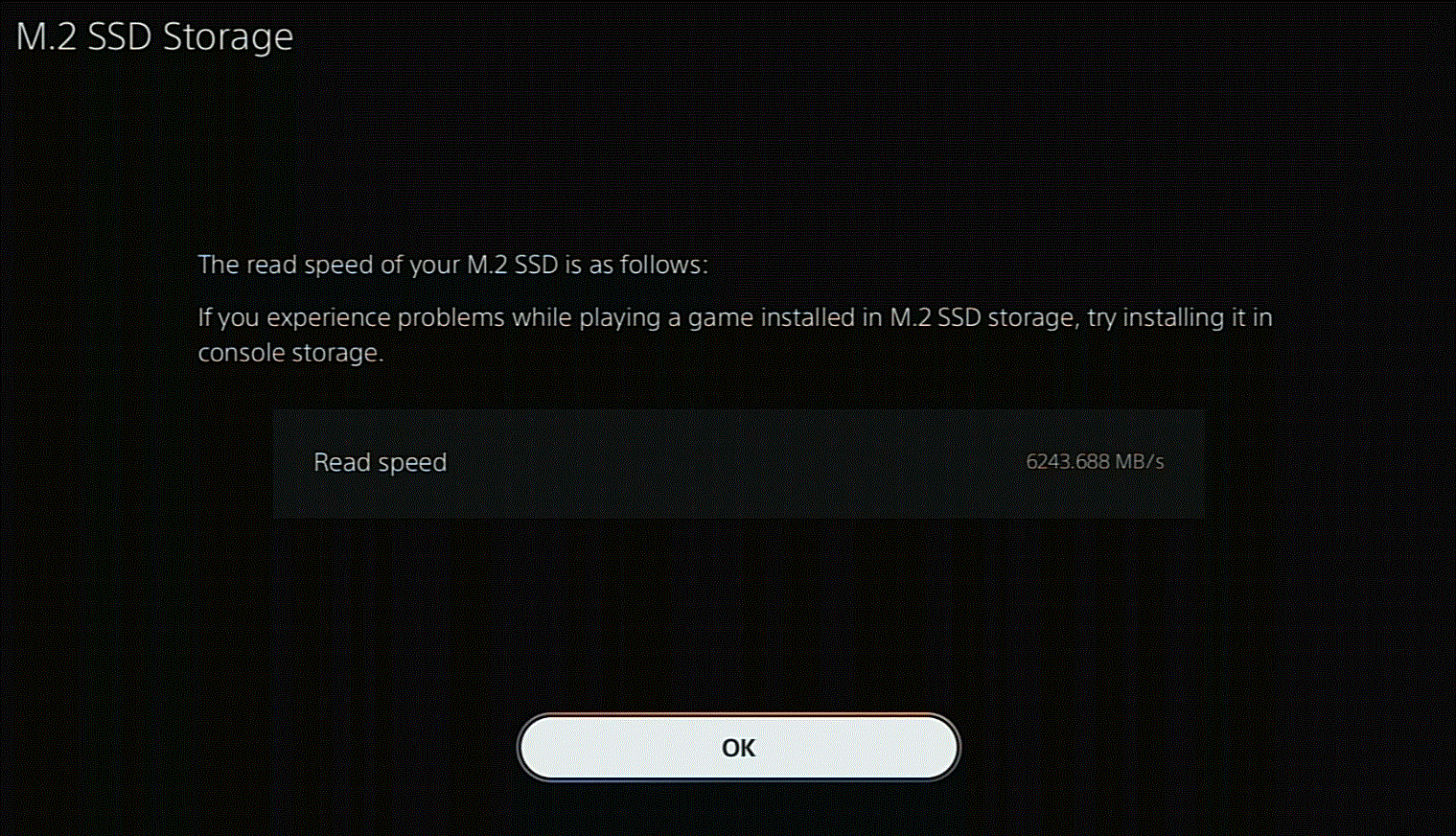
As you would expect, the SSD immediately appeared in the PS5 storage manager and was available for use straight away.
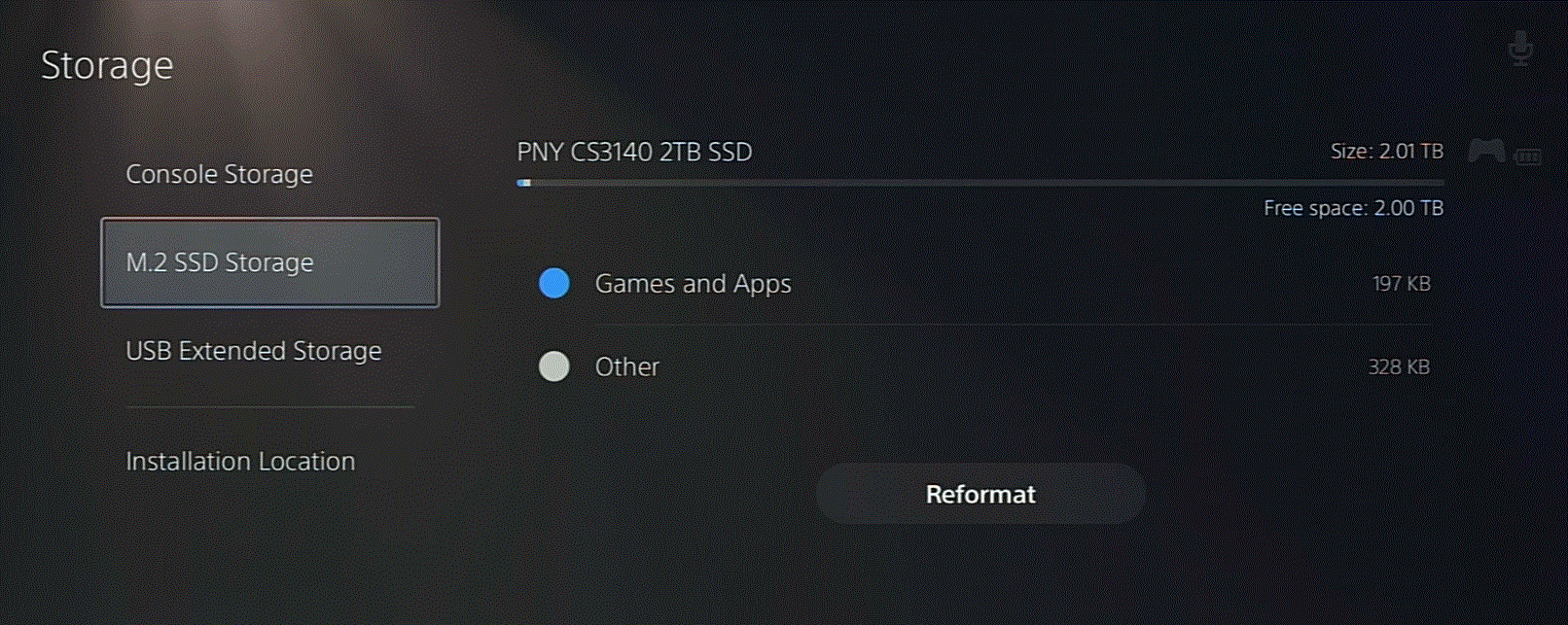
Let’s see how the PNY XLR8 CS3140 PS5 benchmark compared with other SSDs we have tested.
PNY XLR8 CS3140 SSD Review – PS5 Benchmark
To put the PNY XLR8 CS3140 SSD PS5 Performance Benchmark into a little perspective, here is how it compares against the Addlink A95, Adata XPG Gammix S70, Sabrent Rocket 4 Plus and Gigabyte Aorus 7000s – four SSDs that are all PS5 supported and VERY similar architecture very little difference between the others in this tier, it is a solid benchmark.
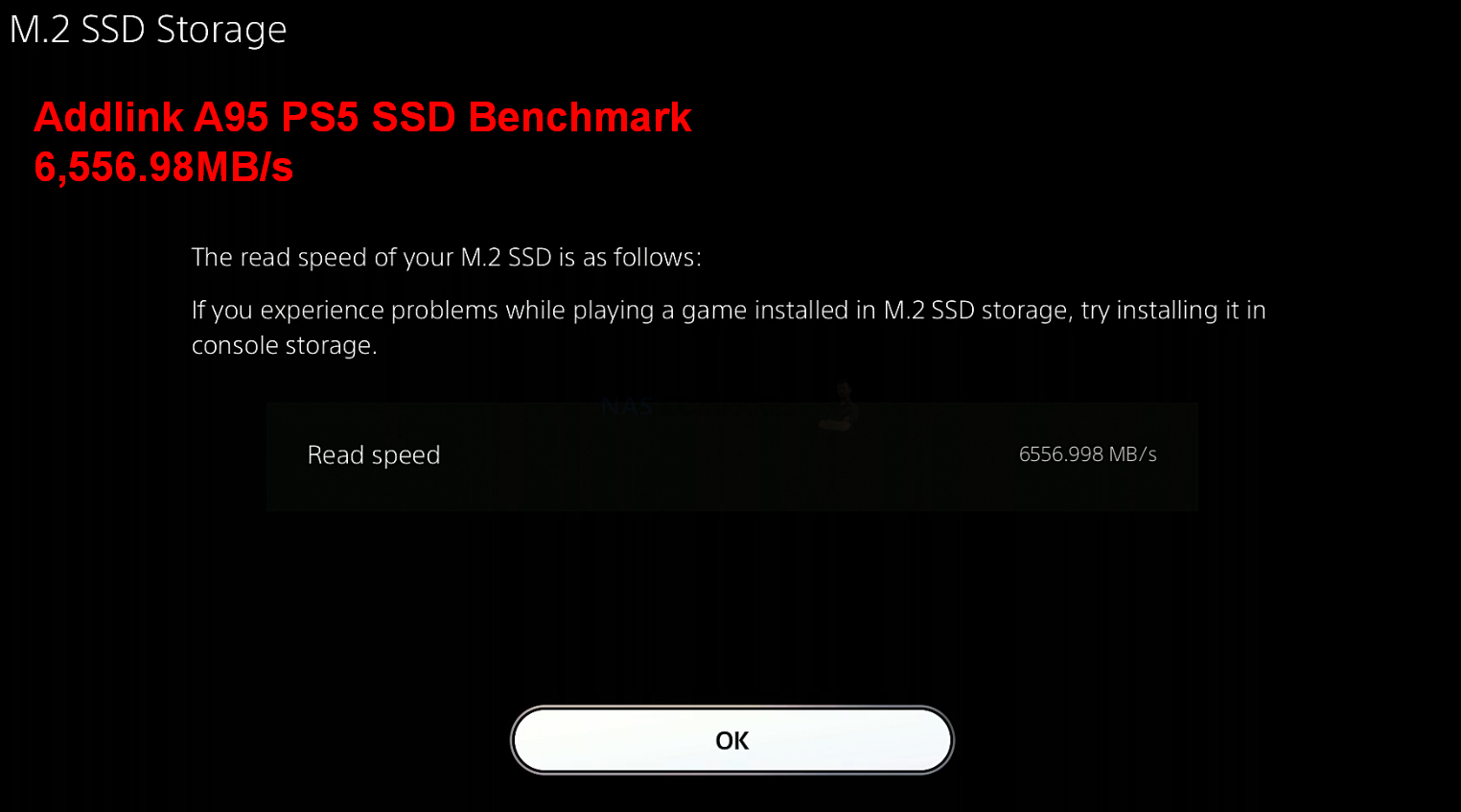 |
 |
| Addlink A95 PS5 Benchmark – 6556MB/s | XPG GAMMIX S70 PS5 Benchmark – 6235MB/s |
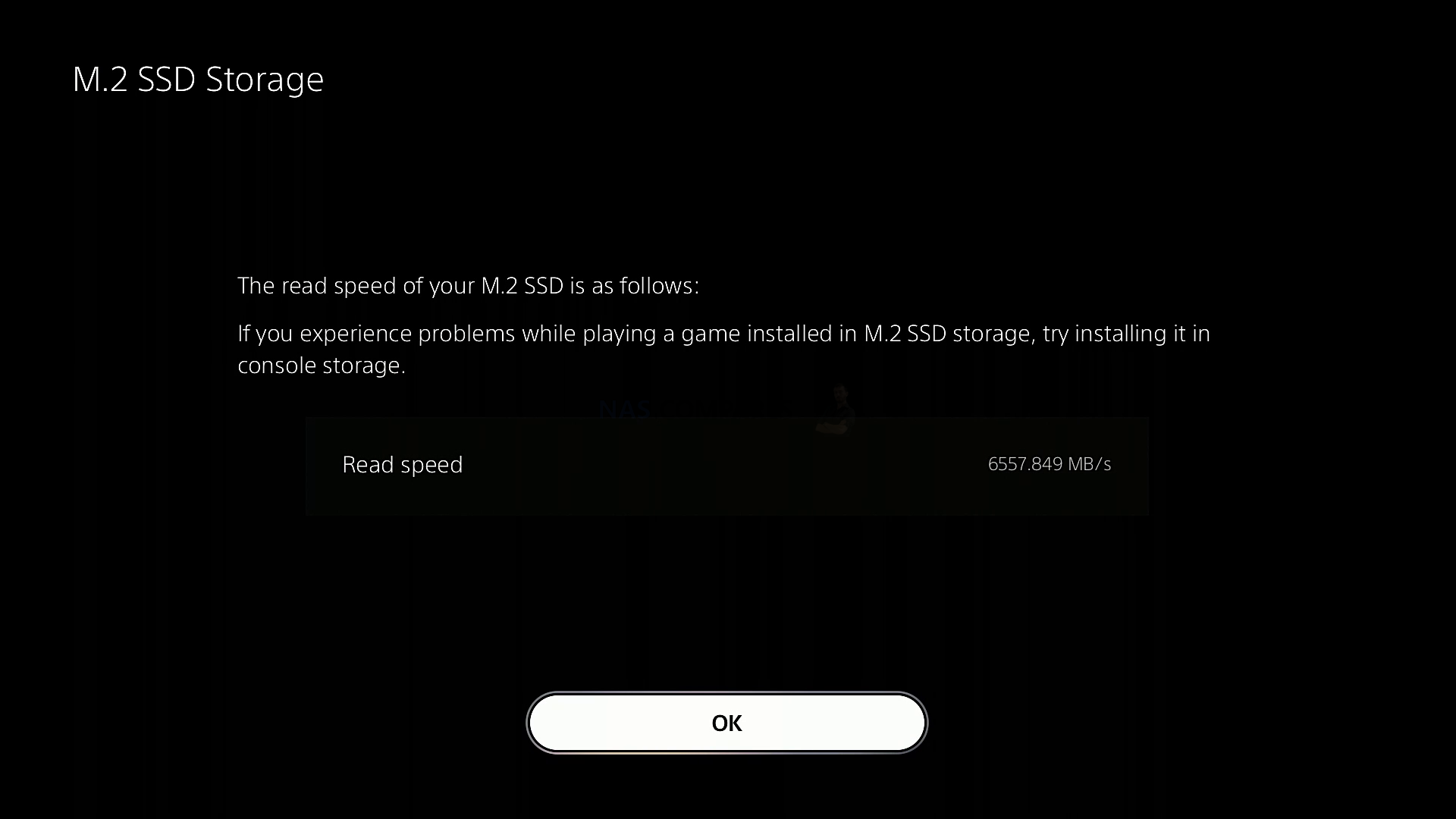 |
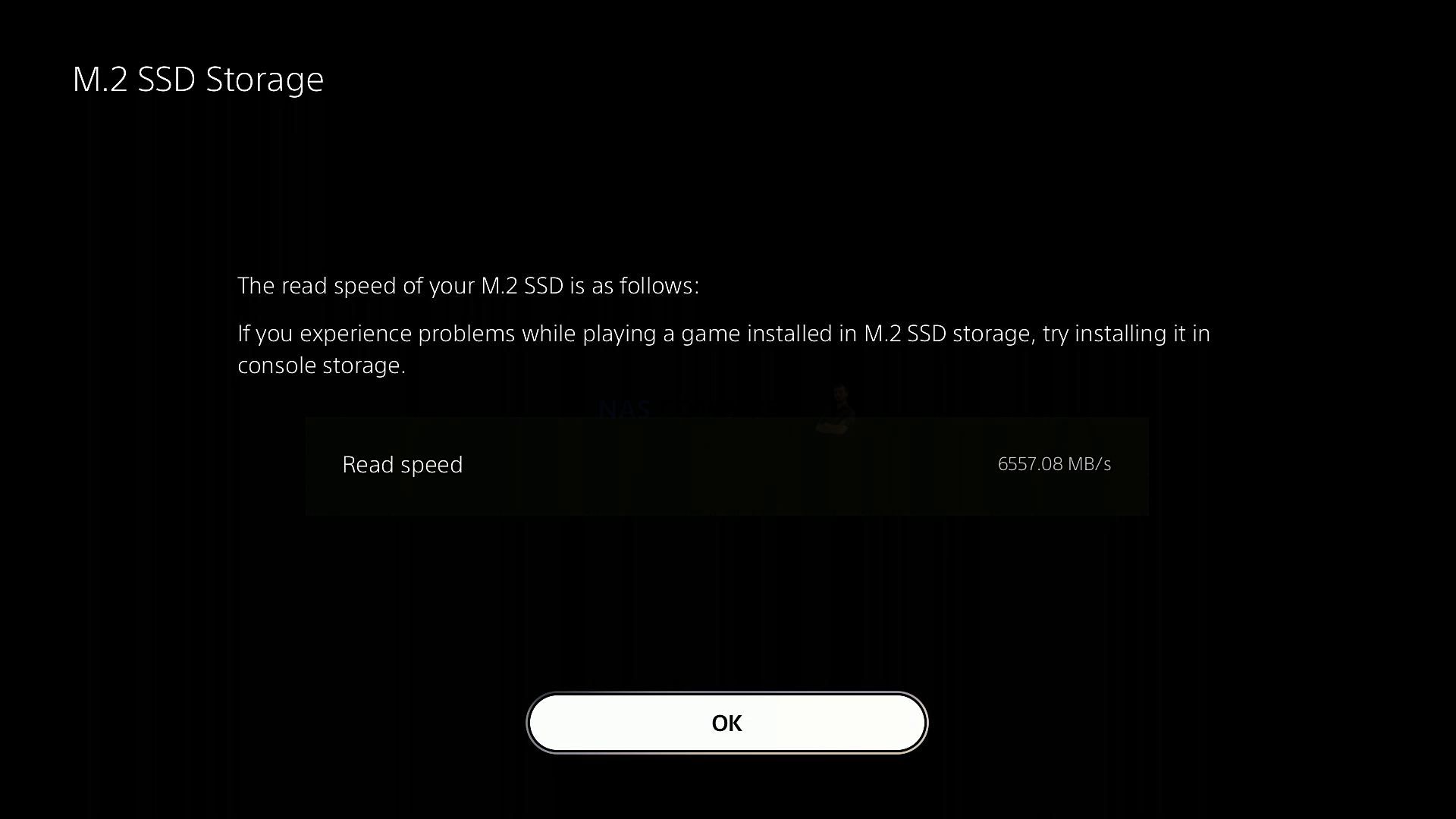 |
| Sabrent Rocket 4 Plus – 6557MB/s | Gigabyte Aorus 7000s PS5 Benchmark – 6557MB/s |
Full PS5 Testing of this is all available as a playlist over on the NASCompares YouTube channel. But for now, let’s carry on with looking at the hardware of the A440, how it conventionally benchmarks and how it compares with currently favourite PS5 SSDs like the WD Black and Seagate Firecuda 530,
So that is the physical design of the PNY XLR8 CS3140 SSD. But what about the hardware components themselves? Does the PNY XLR8 CS3140 cut the mustard in terms of current generation hardware and protocols? Let’s find out.
PNY XLR8 CS3140 SSD Review – Hardware Specifications
As you might expect from an M.2 NVMe SSD that boldly promises performance of over 7,000MB/s sequential read (ie BIG data), the hardware specifications and architecture of the PNY XLR8 CS3140 are quite modern. Indeed, for all the big talk of the Seagate Firecuda 530 hardware (still currently the ‘score to beat’ PCIE Gen4 m.2 NVMe right now) being top tier, the PNY XLR8 CS3140 is pretty darn similar on the spec sheet! Below is how it looks:
| PNY XLR8 CS3140
|
|
| PCIe Generation | PCIe 4 x4 |
| NVMe Rev | NVMe Rev. 1.4 |
| NAND & Memory | Micron 96L 3D TLC & SK Hynix DDR4 |
| Max Capacity | 2TB (4TB Coming soon) |
| Controller | Phison PS5018-E18-41 |
| Warranty | 5 Years |
I know a lot of the above will seem needlessly technical, so below we can bring the most important considerations into sharper focus.
Hardware Focus of the PNY XLR8 CS3140 SSD Series
The first big, BIG thing to remember here is the controller, that Phison E18. An SSD is much like a microcosm version of a whole computer. The Controller is equivalent to the CPU, and Phison are one of the bigger 3rd party SSD controller manufacturers in the world! I say 3rd party, because some long-running storage brands like Samsung and WD have most of their development and hardware engineering ‘in-house’ and use their own branded controllers. Whereas some brands source some/all components for their SSDs from 3rd parties – which is not necessarily a bad thing for both them and the industry (there are pros and cons on either side). Phison has been at the cutting edge of this subject for years now and the E18 was first revealed last year in 2020, but due to the pandemic making storage trends unpredictable and semi-conductor shortages, most SSDs that utilized the Phison E18 eventually arrived in 2021. This controller is one of the biggest reasons that the PNY XLR8 CS3140 can actually back up it’s promises about the 7,000MB/s+ (reporting a max 7,500) Sequential Read (sequential data = big chunks of data). However, that is not the only reason.
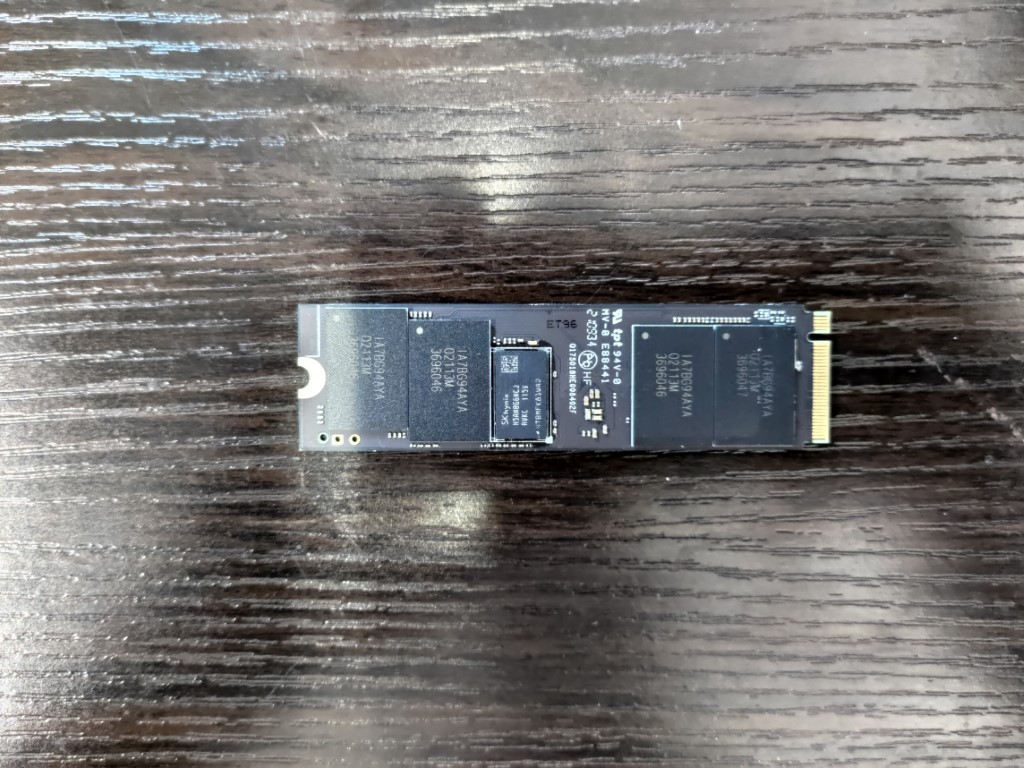
The NAND on the PNY XLR8 CS3140 is where the data lives! SSDs (as you no doubt know) do not use moving parts as found in traditional hard drives and instead uses cells that are charged and data is read/written to them in this process. The quality of the NAND and the layers used will make a big difference to the durability and performance of an SSD and although the PNY XLR8 CS3140 does not provide the best SSD in the industry at this tier right now (that, once again, goes to the Seagate Firecuda 530 at 176 layer 3D TLC NAND), it is bigger than most, arriving at 96 Layers of 3D TLC NAND. Although the majority of modern PCIe M.2 SSD use 3D TLC NAND (avoid QLC NAND like the PLAGUE btw!), most are still at 64 layers or so, this is a big jump up for the PNY XLR8 CS3140 SSD.
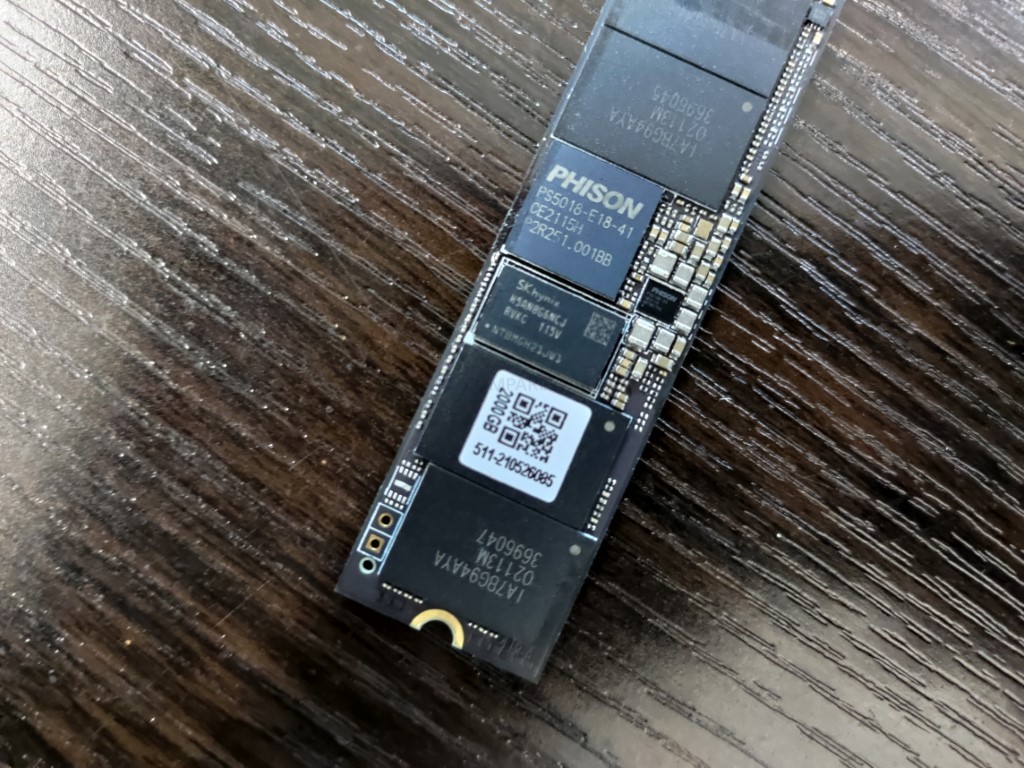
Much like the Controller on the PNY XLR8 CS3140 being the ‘CPU’, it also has an area of memory. The PNY XLR8 CS3140 SSD uses 1GB 2666Mhz DDR4 memory on board and this in conjunction with the SSD provides a massive body of data handling resources for getting your data moving through the SSD and out of the m.2 NVMe PCIe 4 interface. The amount of memory scales in conjunction with the 1TB or 2TB SSD you use, with 2GB of DDR4 at the on the 2TB tier, 1GB DDR4 on the 1TB, etc.
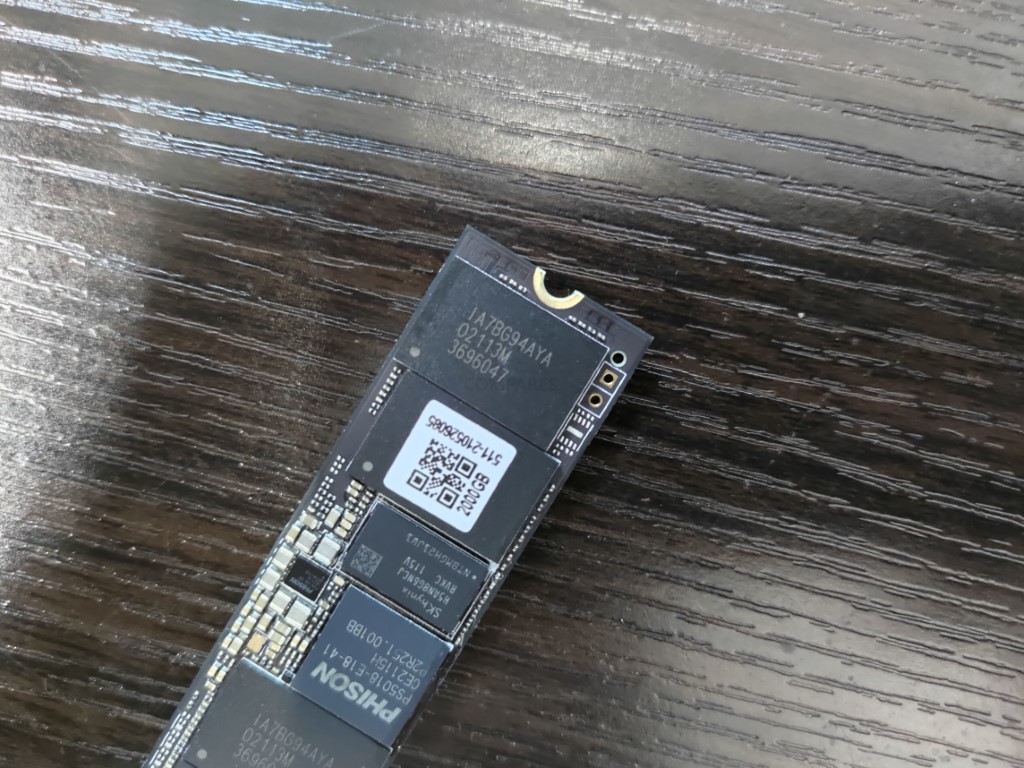
As mentioned, all available capacities of the PNY XLR8 CS3140 arrive at 2280 in length. This is quite normal for the 1TB and 2TB versions, but the fact that the 2TB can arrive on single-sided SSD boards is very impressive. Physical storage NAND is distributed evenly in order to space out the storage and allow even cooling, NAND wear and performance.
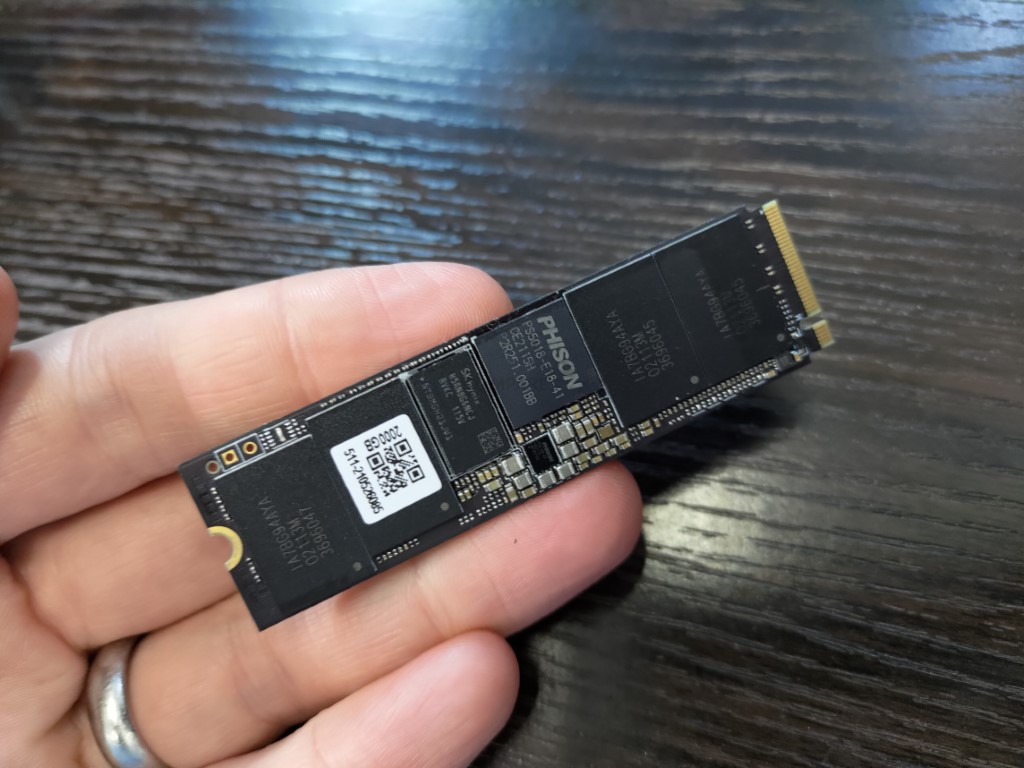
Finally, there is the M.2 NVMe connection. Not all m.2 SSDs are created equal and although M.2 SATA and M.2 NVMe look similar, they provide massively different performance and connectivity. However, the PNY XLR8 CS3140 takes it one step further, by using a newer generation of PCIe Connectivity. In short, M.2 NVMe SSDs are connected to the host PC/Console system via PCIe protocol (think of those slots that you almost always use for your graphics cards, but a much, MUCH smaller connector). These allow much larger bandwidth (ie maximum speed) for the connected storage media, Much like regular PCIe slots, they have different versions (i.E PCIe Gen 1, 2, 3, 4, etc) and also a multiplying factor (x1, x2, x4, etc). Up until around 18 months ago, the best M.2 NVMes were M.2 PCIe Gen 3×4 (so a maximum 4,000MB/s possible). However, never generation SSD like the PNY XLR8 CS3140 use PCIe Gen 4×4 (a potential 8,000MB/s possible) and it is only now that SSD controllers and NAND production has reached a point where it can catch up and fully saturate (i.e fill) this connection.
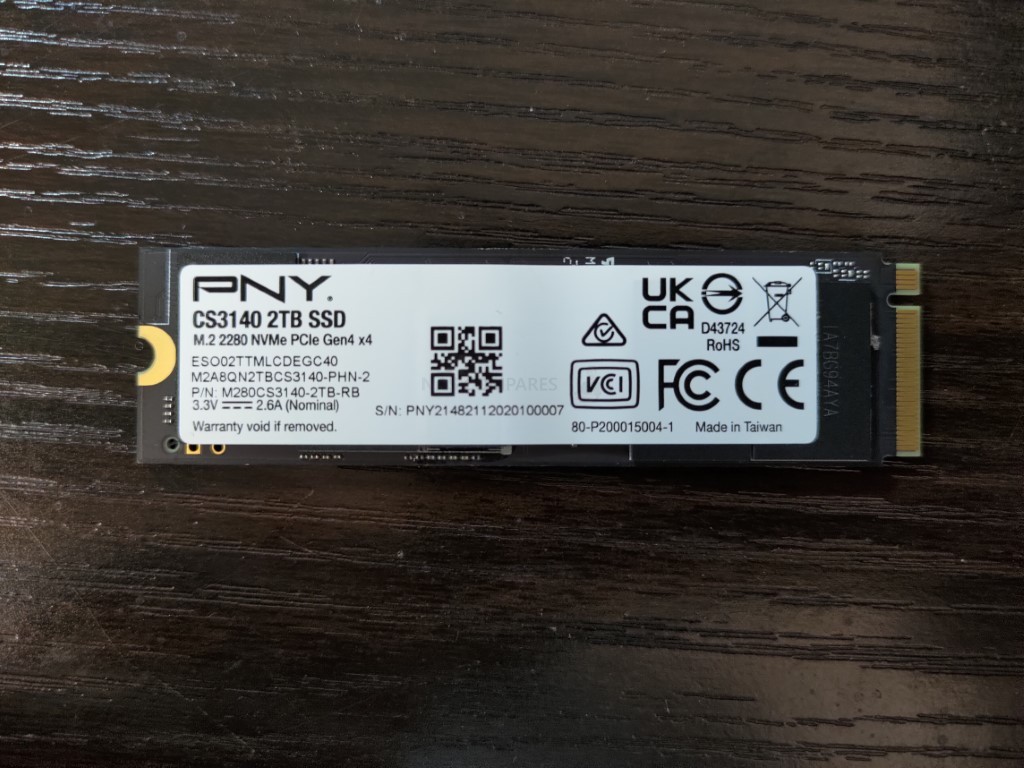
Overall, you really cannot fault the hardware inside/onboard the PNY XLR8 CS3140, as it is still (10 months after release) higher performing in sequential Read and Write than many other M.2 NVMe PCIe 4 SSDs released in that time. Before we go into the full testing, however, it is worth taking a moment to look closely at the reported performance benchmarks of the PNY XLR8 CS3140, as although the performance seems stellar, there are areas such as IOPS and endurance when compared with its main rivals that are worth taking into consideration.
PNY XLR8 CS3140 SSD Review – Official Stats First
Before we conduct our own testing on this SSD, Let’s take a closer look at the reported specifications and benchmarks first. The PNY XLR8 CS3140 SSD arrives in multiple capacities (below). The Prices currently are a little inconsistent (with each higher capacity tier actually having a higher price per GB – quite unusual) likely due to the hardware shortages, the Pandemic, Chia has affected SSD availability in the last 12 months and most recently the announcement that PS5 supports this SSD and it has increased the current price of both models around 20-30%! That said, the PNY XLR8 CS3140 has actually managed to maintain that price point and (surprisingly( even lower a bit in the last 6 months (despite having a budget option in the CS3140 SSD). Below is a breakdown of how each PNY XLR8 CS3140 SSD compares:
| Brand/Series | PNY XLR8 CS3140
|
Seagate Firecuda 530
500GB – $149.99, 1TB – $239.99, 2TB – $489.99, 4TB – $949.99 |
WD Black SN850
|
| PCIe Generation | PCIe Gen 4 | PCIe Gen 4 | PCIe Gen 4 |
| NVMe Rev | NVMe 1.4 | NVMe 1.4 | NVMe 1.4 |
| NAND | 3D TLC Micron 96L | 3D TLC Micron B47R 176L | BiCS4 96L TLC |
| Max Capacity | 4TB – Double Sided | 4TB – Double Sided | 2TB |
| Controller | Phison E18-PS5018 | Phison E18-PS5018 | WD_BLACK G2 |
| Warranty | 5yr | 5yr | 5yr |
| 500GB Model | N/A | ZP500GM3A013 | WDS500G1X0E-00AFY0 |
| Price in $ and $ | N/A | $139 / £119 | $119 / £99 |
| 1TB Model | M280CS3140-1TB-RB | ZP1000GM3A013 | WDS100T1X0E-00AFY0 |
| Price in $ and $ | $169 / £169 | $239 / £199 | $249 / £169 |
| 2TB Model | M280CS3140-2TB-RB | ZP2000GM3A013 | WDS200T1X0E-00AFY0 |
| Price in $ and $ | $339 / £289 | $419 / £379 | $399 / £339 |
| 4TB Model | M280CS3140-4TB-RB | ZP4000GM3A013 | N/A |
| Price in $ and $ | $789 / £699 | $949 / £789 | N/A |
| 500GB Model | N/A | ZP500GM3A013 | WDS500G1X0E-00AFY0 |
| Total Terabytes Written (TBW) | N/A | 640TB | 300TB |
| Mean Time Between Failures (MTBF, hours) | N/A | 1,800,000 | 1,750,000 |
| DWPD | N/A | 0.7DWPD | 0.3DWPD |
| 1TB Model | M280CS3140-1TB-RB | ZP1000GM3A013 | WDS100T1X0E-00AFY0 |
| Total Terabytes Written (TBW) | 700TB | 1275TB | 600TB |
| Mean Time Between Failures (MTBF, hours) | 2,000,000 | 1,800,000 | 1,750,000 |
| DWPD | 0.38DWPD | 0.7DWPD | 0.3DWPD |
| 2TB Model | M280CS3140-2TB-RB | ZP2000GM3A013 | WDS200T1X0E-00AFY0 |
| Total Terabytes Written (TBW) | 1400TB | 2550TB | 1200TB |
| Mean Time Between Failures (MTBF, hours) | 2,000,000 | 1,800,000 | 1,750,000 |
| DWPD | 0.38DWPD | 0.7DWPD | 0.3DWPD |
| 4TB Model | M280CS3140-4TB-RB | ZP4000GM3A013 | N/A |
| Total Terabytes Written (TBW) | 2800TB | 5100TB | N/A |
| Mean Time Between Failures (MTBF, hours) | 2,000,000 | 1,800,000 | N/A |
| DWPD | 0.38DWPD | 0.7DWPD | N/A |
There are clear throughput improvements as you rise through the capacity tiers (not unusual), as does the rated 4K IOPS. Though one area worth focusing on a little is that TBW (terabytes Written) and DWPD (Drive writes per day), as this drive is rated a pinch higher than the Samsung 980 Pro and WD Black SN850 in terms of NAND lifespan on daily writes, likely down to that Micron 96 Layer 3D TLC NAND used, rather than t used by those used by competitors. This is an important point because the brand has significantly less pedigree in-home/business SSD media than the likes of Samsung, WD and Seagate and people will want to know they are going to get a product that lasts!
However, despite the use of the Phison E18 controller and 96 layer NAND, the reported IOPS on each capacity is actually a noticeable degree lower than those reported by their competitors. Indeed, the PNY XLR8 CS3140 is one of the few E18 SSDs that does not state it’s reported 4K random IOPS on the official pages,so it does make me wonder where the disparity stems from. Indeed, when you look at the bulk of PCIe 4×4 M.2 NVMe 1.4 SSD, that feature the E18 controller and 96L (or higher) on board, it really leaves about 10 other SSDs in the market today that this can be compared against, such as the Sabrent Rocket 4 Plus, the MSI Spatium M480, the ADATA Gammix S70 and (current leader) the Seagate Firecuda 530. Of those, the only one that seemingly ‘out specs’ the PNY XLR8 CS3140 is the Seagate Firecuda 530. However, the PNY XLR8 CS3140 SSD has been available in the market for almost 3-4 months longer and has certainly embedded itself in the market at that time a fraction more. Below is how these two drives compare:
| Brand/Series | PNY XLR8 CS3140
|
Seagate Firecuda 530
500GB – $149.99, 1TB – $239.99, 2TB – $489.99, 4TB – $949.99 |
WD Black SN850
|
| 500GB Model | N/A | ZP500GM3A013 | WDS500G1X0E-00AFY0 |
| Sequential Read (Max, MB/s), 128 KB | N/A | 7000MB | 7000MB |
| Sequential Write (Max, MB/s), 128 KB | N/A | 3000MB | 4100MB |
| 1TB Model | M280CS3140-1TB-RB | ZP1000GM3A013 | WDS100T1X0E-00AFY0 |
| Sequential Read (Max, MB/s), 128 KB | 7500MB | 7300MB | 7000MB |
| Sequential Write (Max, MB/s), 128 KB | 5650MB | 6000MB | 5300MB |
| 2TB Model | M280CS3140-2TB-RB | ZP2000GM3A013 | WDS200T1X0E-00AFY0 |
| Sequential Read (Max, MB/s), 128 KB | 7500MB | 7300MB | 7000MB |
| Sequential Write (Max, MB/s), 128 KB | 6850MB | 6900MB | 5100MB |
| 4TB Model | M280CS3140-4TB-RB | ZP4000GM3A013 | |
| Sequential Read (Max, MB/s), 128 KB | 7500MB | 7300MB | N/A |
| Sequential Write (Max, MB/s), 128 KB | 6850MB | 6900MB | N/A |
| Brand/Series | Seagate Firecuda 530 | WD Black SN850 | |
| 500GB Model | N/A | ZP500GM3A013 | WDS500G1X0E-00AFY0 |
| Random Read (Max, IOPS), 4 KB QD32 | N/A | 400,000 | 1,000,000 |
| Random Write (Max, IOPS), 4 KB QD32 | N/A | 700,000 | 680,000 |
| 1TB Model | M280CS3140-1TB-RB | ZP1000GM3A013 | WDS100T1X0E-00AFY0 |
| Random Read (Max, IOPS), 4 KB QD32 | N/A | 800000 | 1,000,000 |
| Random Write (Max, IOPS), 4 KB QD32 | N/A | 1000000 | 720,000 |
| 2TB Model | M280CS3140-2TB-RB | ZP2000GM3A013 | WDS200T1X0E-00AFY0 |
| Random Read (Max, IOPS), 4 KB QD32 | N/A | 1,000,000 | 1,000,000 |
| Random Write (Max, IOPS), 4 KB QD32 | N/A | 1,000,000 | 710,000 |
| 4TB Model | M280CS3140-4TB-RB | ZP4000GM3A013 | |
| Random Read (Max, IOPS), 4 KB QD32 | N/A | 1,000,000 | N/A |
| Random Write (Max, IOPS), 4 KB QD32 | N/A | 1,000,000 | N/A |
Yes, that is a LONG table, but you can immediately see that the Seagate Firecuda 530 raises the stakes on all of the key specifications. Although there are a number of micro reasons for this, the 176L NAND is the biggest factor here. Yes, that is why the Firecuda 530 commands the higher price tag. Additionally, the WD Black arriving at a better price point, higher IOPS in most tiers and the fact it does this whilst still hitting that 7,000MB/s certainly gives pause for thought. However, for many, the additional cost for higher durability they may never need, peak performance their core system will not reach and IOPS rating that their larger file handling will never utilize will mean that holding out for the Firecuda or WD Black SN850 is not in their interest. Both SSDs (on paper at this stage!) are fantastic examples of where consumer and prosumer SSDs are evolving towards. Let’s get the PNY XLR8 CS3140 on the test machine!
Testing the PNY XLR8 CS3140 m.2 PCIE4 NVMe SSD
The PNY XLR8 CS3140 was selected for this test and it was tested using multiple benchmark tools, from a cold boot, in the 2nd storage slot (i.e not the OS drive). Each test was conducted three times (full details of this are shown in the YouTube Review of the PNY XLR8 CS3140 over on NASCompares):
Test Machine:
- Windows 10 Pro Desktop System
- Intel i5 11400 Rocket Lake – 6-Core 2.6/4.4Ghz
- 16GB DDR4 2666MHz Memory
- Intel B560M mATX Motherboard
- OS Storage, Seagate Firecuda 120 SSD
- Test SSD connected to Secondary PCIe Gen 4 M.2 Slot
Using CrystalDisk, we got a good measure of the drive and verified that this PCIe Gen 4 x4 SSD was indeed using the 4×4 lane. Additionally, the temp averaged out around 41C between each test being conducted.
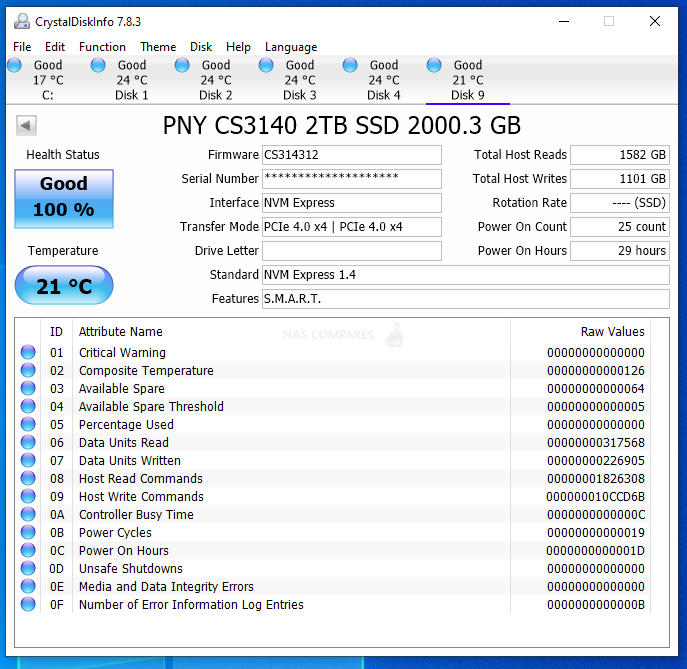
The first tests were conducted using the ATTO disk benchmark software. The first was a 256MB test file size and below is a breakdown of the transfer rates and IOPS. The 2nd Test was a 1GB test file and finally, the last test was with a 4GB test file. The system was given 1-minute cool downtime between tests, no screen recording software was used (remove overhead) and a heatsink was used throughout (no reboots)
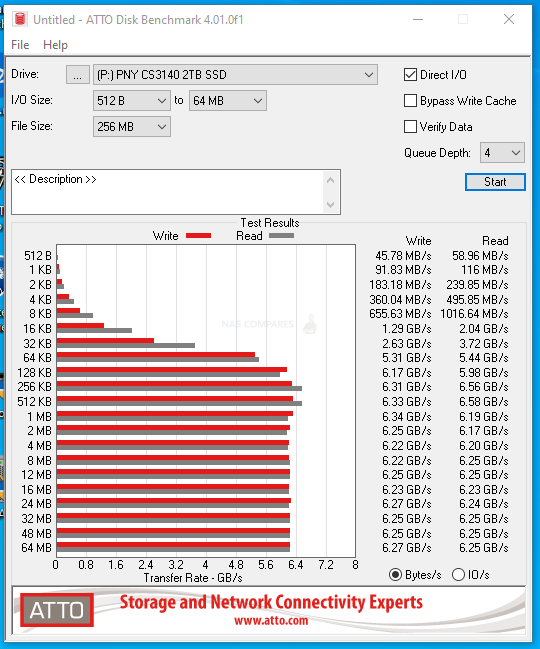 |
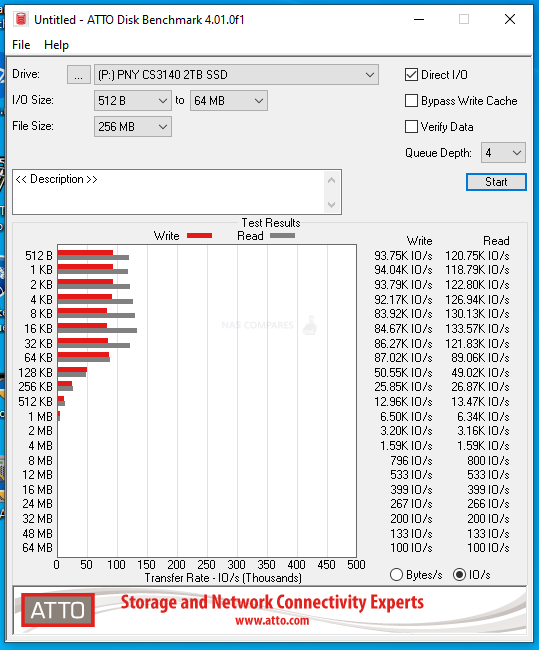 |
ATTO Disk Benchmark Test #1
256MB File PEAK Read Throughput = 6.58GB/s
256MB File PEAK Write Throughput = 6.34GB/s
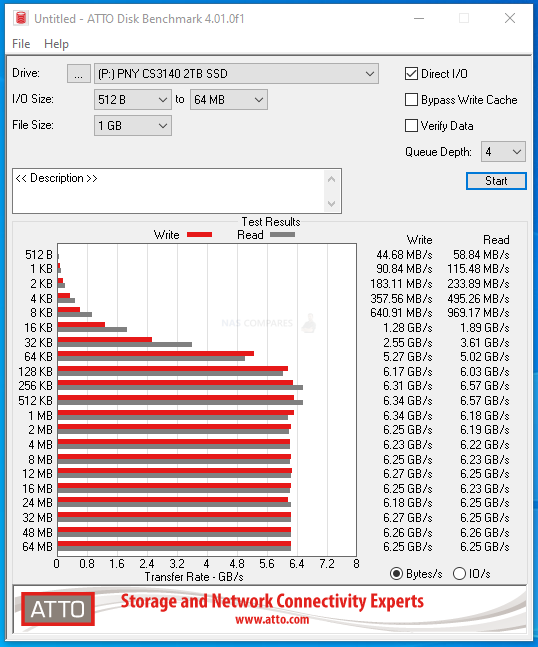 |
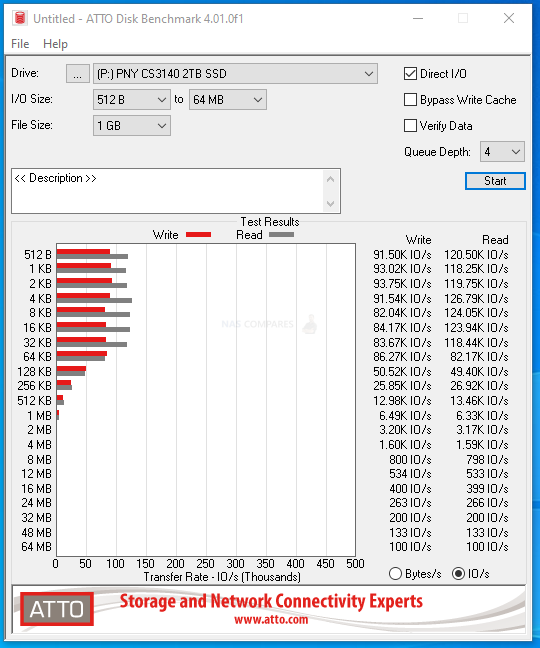 |
ATTO Disk Benchmark Test #2
1GB File PEAK Read Throughput = 6.57GB/s
1GB File PEAK Write Throughput = 6.34GB/s
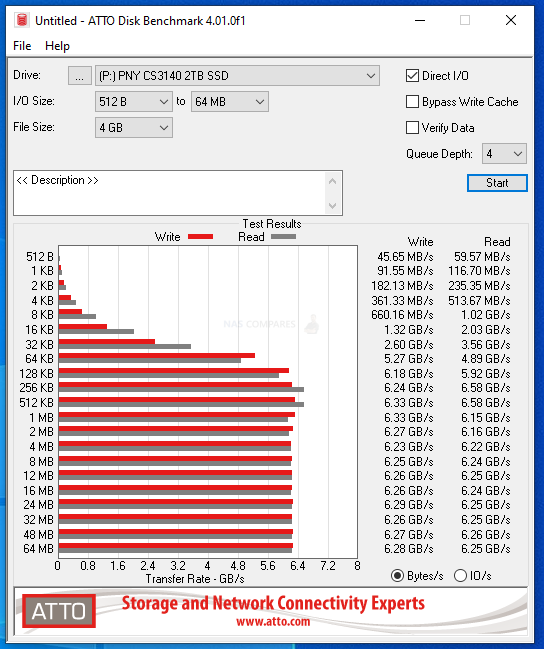 |
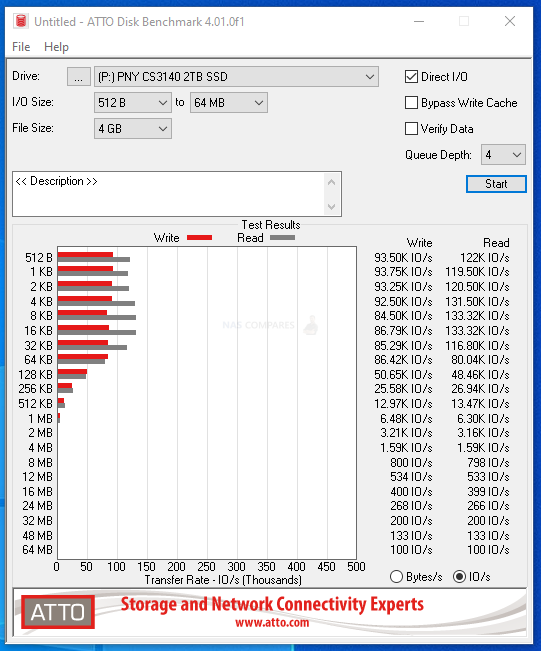 |
ATTO Disk Benchmark Test #3
4GB File PEAK Read Throughput = 6.58GB/s
4GB File PEAK Write Throughput = 6.27GB/s
Next, although the ATTO tests were quite good, but not what I would have hoped from this SSD, so I moved on to the Crystal Disk Mark testing to see how well it would handle our lasts barrage of tests. The first test was the 1GB file testing, which measured both sequential and random, as well as the read and write IOPS. Test were conducted on a 1GB, 4GB and 16GB Test File. I also included a mixed 70/30 read and write task to give a little bit more of a realistic balanced workload. These tests were conducted with 1-minute cooling break in between
CRYSTALDISK MARK 1GB TEST

CRYSTALDISK MARK 4GB TEST
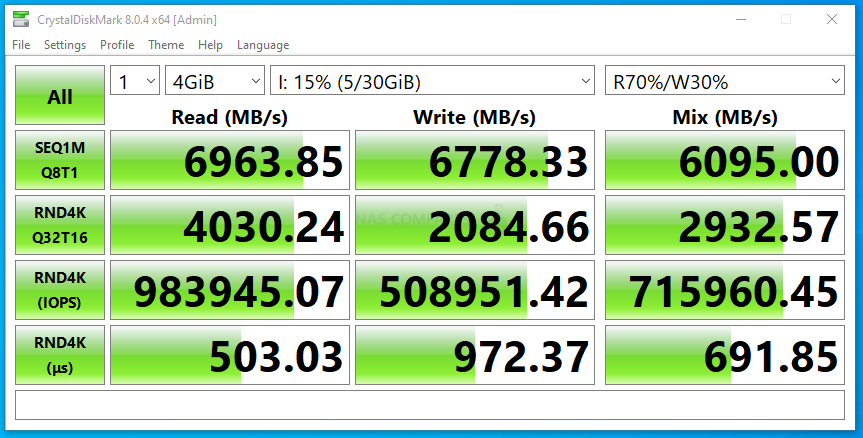
CRYSTALDISK MARK 16GB TEST
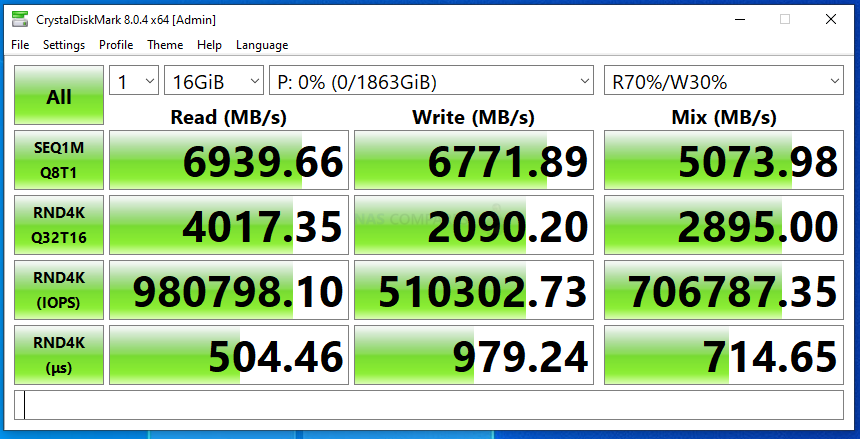
Next, I switched to AS SSD benchmark. A much more thorough test through, I used 1GB, 3GB and 5GB test files. Each test includes throughput benchmarks and IOPS that are respective to the larger file sizes (important, if you are reading this and trying to compare against the reported 4K IOPS from the manufacturer).
AS SSD Benchmark Test #1
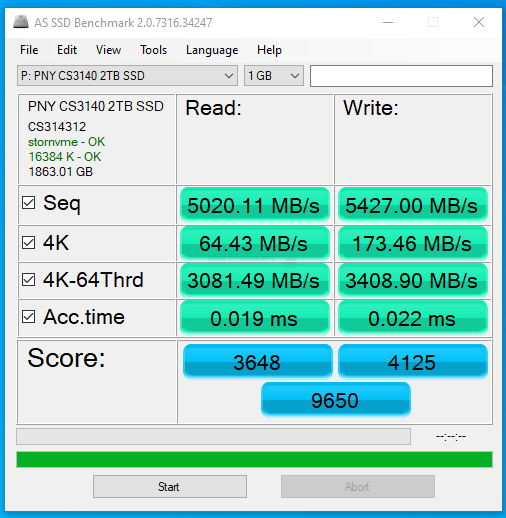 |
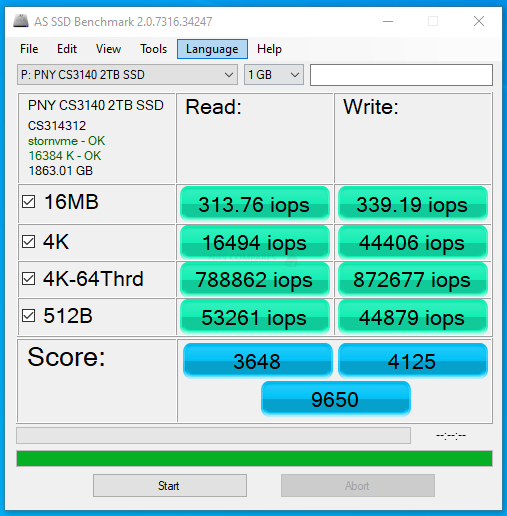 |
AS SSD Benchmark Test #2
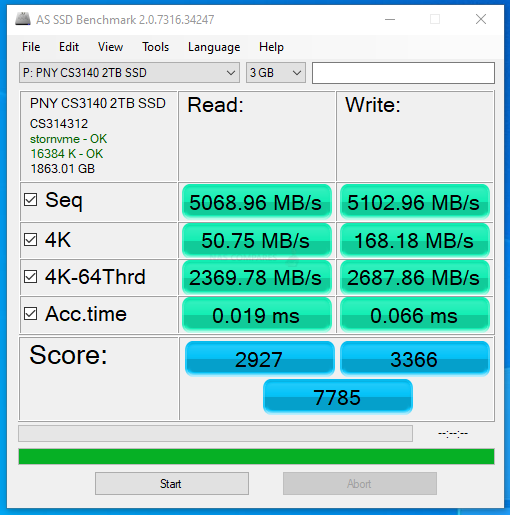 |
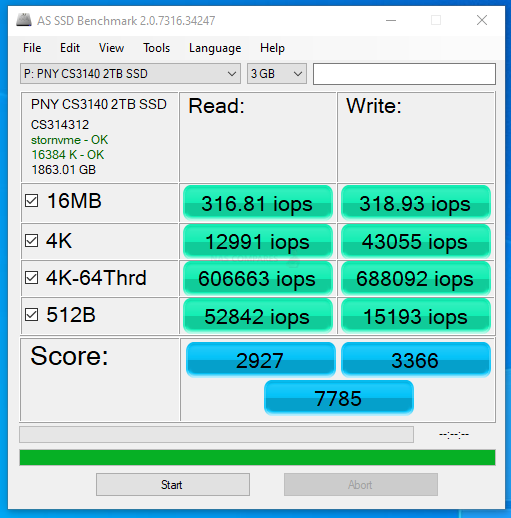 |
AS SSD Benchmark Test #3
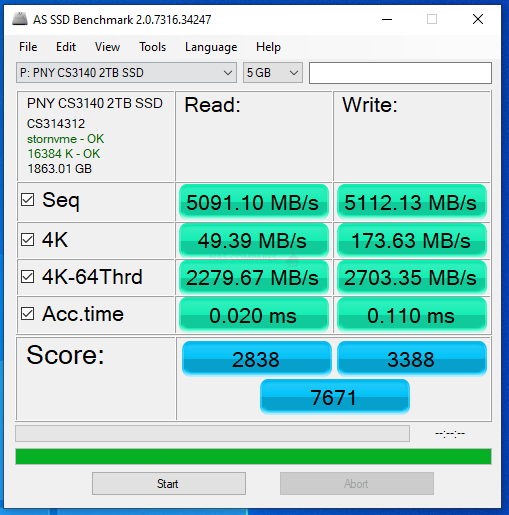 |
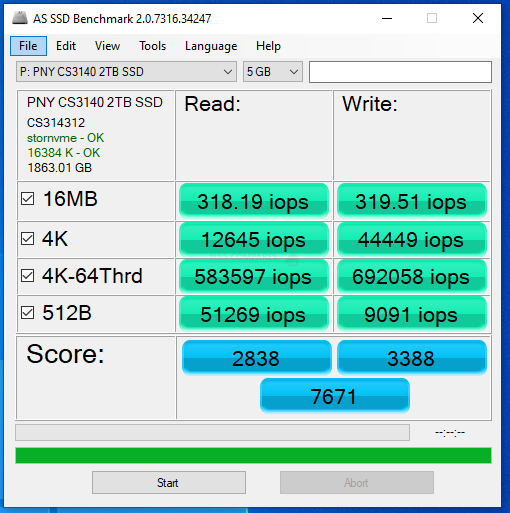 |
Ordinarily, I would introduce tests like BlackMagic and AJA into the mix here, but even a short burst of testing on an NVMe like this would over saturate the cache memory on board. Nevertheless, in the short term we still could ascertain the reported performance on 1GB, 4GB and 16GB file testing was:
1GB AJA File Test Results (Peak) = 5835MB/s Read & 5329MB/s Write

4GB AJA File Test Results (Peak) = 5874MB/s Read & 5535MB/s Write

16GB AJA File Test Results (Peak) = 5900MB/s Read & 5594MB/s Write

Overall, the PNY XLR8 CS3140 was certainly able to provide some solid performance, as well as potentially exceed the test figures here on a more powerful machine. Given the reported Read and Write statistics that the brand has stated publically, I think there is enough evidence here to back up those claims. IOPs were a little lower than I expected (I hoped to see them cross into the 1Million mark), but again, we were testing very large file types, so this would have to be taken in context.
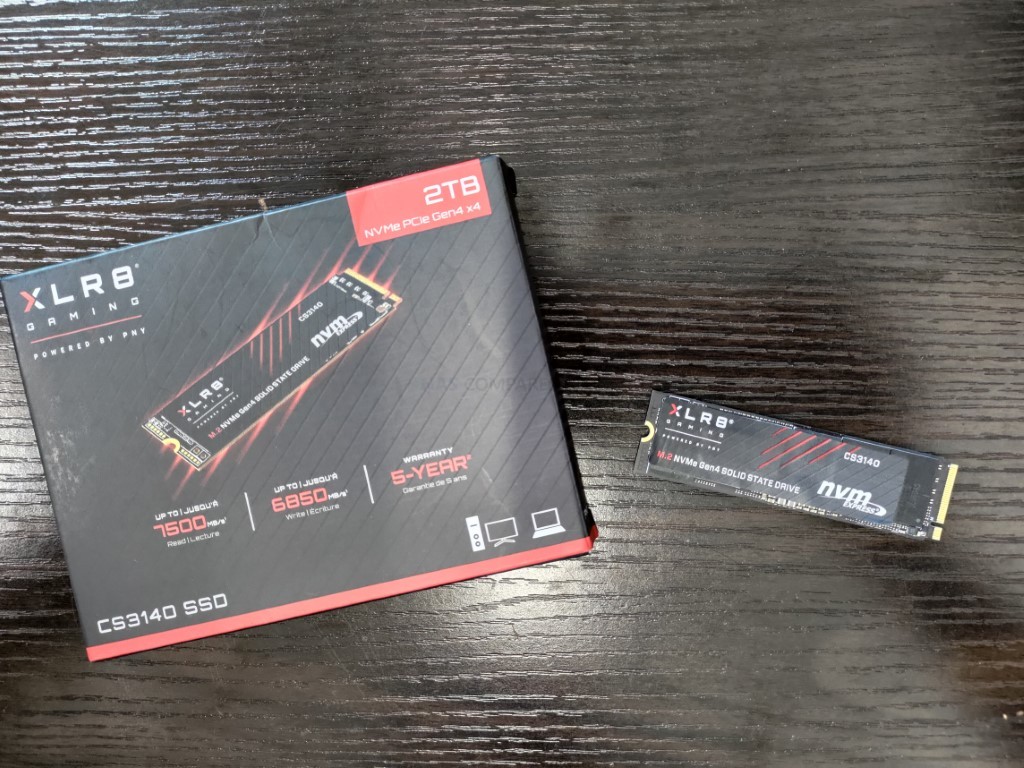
PNY XLR8 CS3140 SSD Review – Conclusion
The PNY XLR8 CS3140 SSD is a solid enough SSD that although holds back on the presentation a little bit, more than makes up for it in top tier performance, fair pricing and not overpromising what it can do. In many SSDs cases, the marketing of these drives might be overestimating what they can do, or keeping quiet about where it falls short, however in the case of the PNY XLR8 CS3140 we have an honestly presented and reliable SSD. Add to that the recent release of the brand’s own PS5 heatsink and you have every approachable bundle purchase here that a lot of straightforward console buyers will be drawn to.
The architecture of the PNY XLR8 CS3140 (Phison E18, Micron 3D TLC 96L NAND, 0.38DWPD, etc) might well be a recipe we have seen oft-repeated by SSD brands in the last 12 months over and over again, but the CS3140’s strength is in providing this at a price point notably lower than most. That said, low availability and a sudden gear shift by the brand to move its PC gaming label ‘XLR8’ to extend towards PS5 notoriety is not quite as strong as it might like. Overall, there is little reason not to choose this for your PS5 purchase and in particular if the PS5 designed heatsink bundle appears in your region. A predictable, but still very worthy SSD in 2022.
| PROs of the PNY XLR8 CS3140 | CONs of the PNY XLR8 CS3140 |
| Another good Phison E18 SSD
Good Price Point vs WD & Seagate Options Genuinely Impressive value for the price tag PS5 Compatibility Confirmed PS5 designed Heatsink bundles are available No overpromising of its abilities and solid performance Durability a pinch better than the WD Black SN850 and Samsung 980 Pro Impressively high write performance compared with similar architecture SSD |
The retail package is a little underwhelming
Availability is weaker than other brands Specifications could be clearer online |
🔒 Join Inner Circle
Get an alert every time something gets added to this specific article!
This description contains links to Amazon. These links will take you to some of the products mentioned in today's content. As an Amazon Associate, I earn from qualifying purchases. Visit the NASCompares Deal Finder to find the best place to buy this device in your region, based on Service, Support and Reputation - Just Search for your NAS Drive in the Box Below
Need Advice on Data Storage from an Expert?
Finally, for free advice about your setup, just leave a message in the comments below here at NASCompares.com and we will get back to you. Need Help?
Where possible (and where appropriate) please provide as much information about your requirements, as then I can arrange the best answer and solution to your needs. Do not worry about your e-mail address being required, it will NOT be used in a mailing list and will NOT be used in any way other than to respond to your enquiry.
Need Help?
Where possible (and where appropriate) please provide as much information about your requirements, as then I can arrange the best answer and solution to your needs. Do not worry about your e-mail address being required, it will NOT be used in a mailing list and will NOT be used in any way other than to respond to your enquiry.

|
 |
Terramaster F4 SSD NAS - Should You Buy? (Short Review)
Minisforum N5 Pro NAS Review - Did Minisforum just WIN at NAS?
What Can You ACTUALLY DO with HDMI on Your NAS?
Best NAS for under $499
Best NAS for Under $250 (2025)
Minisforum N5 Pro NAS - FIRST IMPRESSIONS
Access content via Patreon or KO-FI







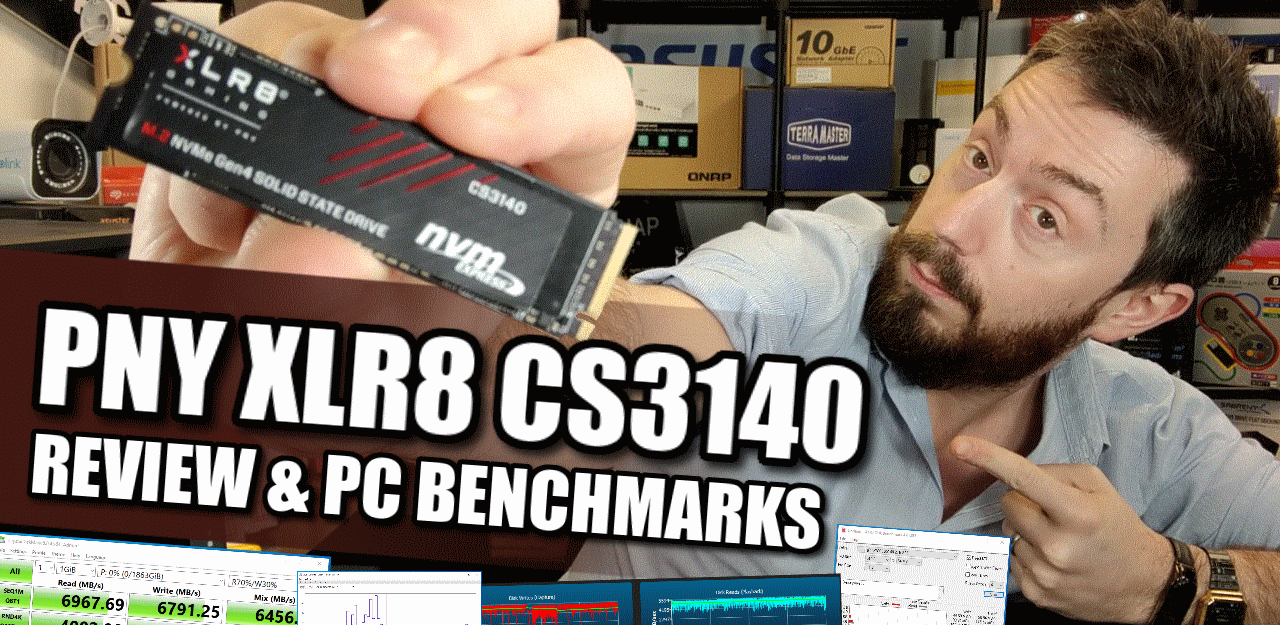







A really good & detailed video ????
REPLY ON YOUTUBE
Got the 4TB version of CS3140. Sadly they silently changed the controller to Innogrit RainierPC instead of the Phison E18..
REPLY ON YOUTUBE
XLR8 – Accelerate
REPLY ON YOUTUBE
Hello..i want buy ssd for ps5. But don’t know which better between PNY and Adata XPG .
REPLY ON YOUTUBE
I found this brand, by comparing it with Samsung, and all the others. Performence per buck….. In Denmark, it is the cheapest option, though with the highest specs…. I’ve used PNY SSD the last 7 years, 2,5″ SSD allso cheap, though the fastest, here in Denmark 😉 Samsung has incredible performence, but I choosed this brand, and have not been let down on performence or reliability! ????????
REPLY ON YOUTUBE
Is there a possibility to install a better thermal pad? For example the Thermalright Thermal Pad 0.5mm 12.8 W/mK?
REPLY ON YOUTUBE
Is this better than an external mechanical drive for Premiere? I do video editing and have 40TB of data. These drives seem tiny. 2TB will fill up in less than a month.
REPLY ON YOUTUBE
is the cs3150 1tb worth it? it’s on sale and actually the only available on local store after searching for weeks.
REPLY ON YOUTUBE
I’m thinking that the xlr8 stands for accelerate
REPLY ON YOUTUBE
Hi, do you have a list of single-sided 2TB SSDs?
REPLY ON YOUTUBE
4:21 “I hate seagulls” ahahahaha. Great review, saw one PNY 2TB on sale locally and wanted to check performance, loved the testing!
REPLY ON YOUTUBE
XLR8 obviously is accelerate
REPLY ON YOUTUBE
I got the 4TB variant for my main desktop. I’m planning on getting a heatsink for it in the future and the 1TB SSHD and HDD will be cloned to the 4TB as 2TB partitions.
REPLY ON YOUTUBE
SSD 2Tb PNY XLR8 CS3140 ?
REPLY ON YOUTUBE
If price was not a factor, would you go for the 2tb pny cs3140 or the 2tb Samsung 980 pro?
*For a pc as c:
REPLY ON YOUTUBE
Yep. I can’t find this heatsink anywhere. Not even on the official site.
REPLY ON YOUTUBE
great review, u are the only one in the world that dare to put iops value. it had been mystery for a year. do u have 1tb version review too ?
REPLY ON YOUTUBE
Mine is reading around 5600 on the PS5, and I have the same one- CS3140 2TB. Even checked the firmware and it’s up to date- I’m so confused.
REPLY ON YOUTUBE
Why is my ps5 read speed on this ssd around 5890? I’ve tried updating the firmware as well and reinstalled it but still about the same speeds. Any solutions?
REPLY ON YOUTUBE
What would you say is the best heatsink for ps5 right now
REPLY ON YOUTUBE
The problem with this drive is that PNY seems to be hiding the endurance rating for it. Looking around their web site and advertisements, it all says 5 year warranty. But, I can’t find anywhere that talks about Terabytes Written (TBW). Yes, the warranty is fine. But the TBW gives an idea of what kind of usage the thing is good for. No problem with a low TBW. But, not advertising the TBW is a badness.
REPLY ON YOUTUBE
Can someone make a counter on how many times he says “SSD” in one video?
REPLY ON YOUTUBE
XLR8 = Accelerate ?
REPLY ON YOUTUBE
Lots of examples of this in US businesses. IBM (International Business Machines) and 3M (Minnesota Mining and Manufacturing) spring to mind.
REPLY ON YOUTUBE
We have a bank here in the USA named PNC. It literally stands for “Previously National City”, which is what the bank chain was originally named.
REPLY ON YOUTUBE
Paris to new York is a wet market lol
REPLY ON YOUTUBE
Another great video. Any chance you get your hands on the arous full copper heatsink. To do a ps5 test?
REPLY ON YOUTUBE
So firecuda is still better . got it , thanks.
REPLY ON YOUTUBE
Hi! Just want to say thank you! Here from the colonies..
REPLY ON YOUTUBE
Finally thanks man, this is what I’ve been running for months now in my PS5, I’m glad you finally got around to it..
REPLY ON YOUTUBE
Great review, short and to the point. Glad to know I didn’t buy a lemon. I’ve been running this with the Sabrent heatsink and it performs well, as I’ve had no issues. Whenever anyone asks what ssd to get on reddit I alway send a link to your top 5 of 2022. Your reviews are the best.
REPLY ON YOUTUBE
Had a few pny sd cards in the past and all of them corrupted over a few months. Definitely won’t be sticking one in my ps5
REPLY ON YOUTUBE
Great review, as always.
In your opinion, which wouldbe the best ssd&heatsink choice for a ps5? (the very best ones)
Thanks ????
REPLY ON YOUTUBE
Thank you Robbie Andrews, I was seriously considering getting this SSD because it’s frequently on sale for $289 for 2tb. Unfortunately, I was gifted a 1tb WDSN850, so I’m not going to buy another ssd, but I’m still grateful for this video.
REPLY ON YOUTUBE
Why can I not buy this in the states? Can’t find it online anywhere
REPLY ON YOUTUBE
Have you ever compared the temperature differences between using the Seagate Firecuda 530 including heatsink with the ssd bay cover versus Seagate Firecuda 530 using the PNY/Sabrent PS5 heatsink? I think that would be a very interesting experiment for those people that can only get the bare drive versions. Or any/all SSD’s that have variants with and without factory installed heatsinks. Love all these PS5 SSD test videos.
Also a heads up for anyone reading this, Amazon and a few other vendors have been selling the Adata XPG Gammix s70 Blade S70 (and full heatsink) for either $125-130 or $145-160 with a $20-29 discount coupon. There are also 2Tb models for $220-250 also with a discount coupon of $10-30.
REPLY ON YOUTUBE
Any thoughts about some complaints regarding the wd sn850 with factory installed heatsink, the thermal pads are not touching the chipsets?
REPLY ON YOUTUBE
Can you do some testing on the Kingston Fury Renegade SSD for PS5 by any chance? I’m torn between it and the Firecuda because their read/write speeds are identical to each other on paper, but the Fury Renegade oddly enough has a heat spreader attached and Kingston says that a heatsink isn’t necessary for it.
REPLY ON YOUTUBE
So the elecgear is always the better one ☝????
REPLY ON YOUTUBE
I’ve meant to ask what’s your quality standard you’re using for thermal pads? Some are much better than others apparently. It could be helpful for others maybe looking to duplicate your performance or decide they want better if cheaper pads are getting xyz result in these tests.
Also thickness for the pad used on the given ssd. I think for the folks new to this that information for those could be helpful. Just a thought for folks that want to copy and paste your set ups for the test.
For anyone reading I’m using an elecgear with Gelid Solutions GP-Extreme thermal pads with the thickness being 1.5mm and 1mm on a Firecuda 530 4tb.
REPLY ON YOUTUBE
Nas do you recommend putting a thermal pad on the bottom of the ssd when using the pny or Sabrent plates? I’m using the sn850 and it’s only a single sided nvme drive?
REPLY ON YOUTUBE
Where are these PNY XLR8 Heatsinks being sold in the USA? Will they be priced similar to the Sabrent model?
REPLY ON YOUTUBE
I got the Sabrent Heatsink. PNY is better? Should I change it?
REPLY ON YOUTUBE
as always great work and I appreciate all the work and time you put into your videos
REPLY ON YOUTUBE
I liked the elecgear to the sabrent and now pny for one reason. The ssd I bought was $900 (firecuda 4tb) and my ps5 is $500. If the ps5 dies it is substantially cheaper to replace lol
I have a feeling the pny will unseat the sabrent between the two of them
REPLY ON YOUTUBE
Can’t find the PNY Heat sink anywhere below plz please?
REPLY ON YOUTUBE
Hey I think it would be great if you documented all of your research and findings into a Google spreadsheet or something like that. And if you can’t. I understand that it takes a good amount of time to do that with all of your previous reviews on heatsinks and all of the different ssd,s that you can install in the ps5
REPLY ON YOUTUBE
I enjoy all the heatsink reviews thankyou, but is the best option to buy the SSD where the manufacturer has installed the heatsink at production. Or is it best to buy the SSD without heatsink and add a third party heatsink? What are your thoughts on this?
REPLY ON YOUTUBE
So PNY is equal or slightly better than the Sabrent, Will buy the cheaper option with Firecuda SSD.
I really want to wait for your big review but Horizon & Elden Ring are almost out and i want the best upgrades for preformance.
Thank you for your analysis.
REPLY ON YOUTUBE
Don’t understand your Elecgear critism.
Nobody had any issues with the heatsink and It achieves the lowest temperatures possible. It causes no harm to the PS5 system.
About the PNY It looks like it’s a little better than the Sabrent. They achieve the lower temperatures with their own special design. Problem of the PNY is the price and the availability.
REPLY ON YOUTUBE
Is this is heatsink actually out yet? I live in the US can’t find it anywhere for sale
REPLY ON YOUTUBE
First.????
REPLY ON YOUTUBE